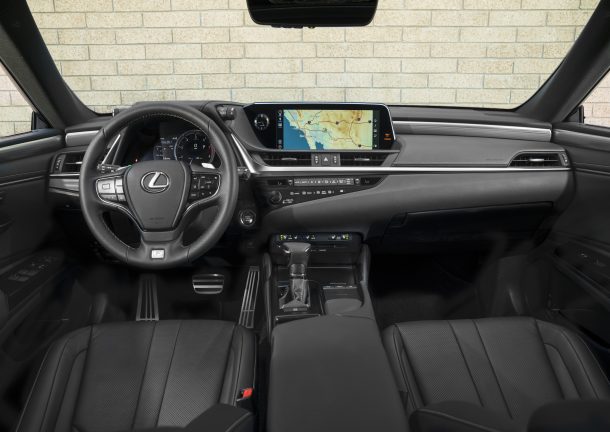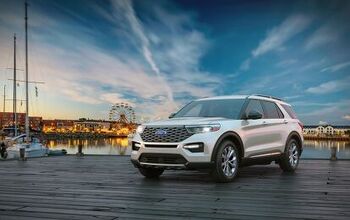2019 Lexus ES: The Most Conservative Car in the Lexus Barn Lets Its Hair Down, Dons F Sport Label

Long the preferred ride of the casual golf membership set, the Lexus ES enjoys a reputation of high reliability and very gradual change. Toss that cred out the window, as the 2019 ES undergoes what’s arguably the most significant revamp in its nearly three-decade-long history.
Revealed Wednesday in Beijing, the new ES rides atop a platform shared with its fellow Kentucky-built stablemate, the Toyota Avalon, and grows in all the time-honored ways. It’s longer, lower, and wider than the outgoing version. More power and more speeds come to the sedan’s sole powertrain, while the body undergoes a transformation that takes years off (the age of its perceived driver).
With this 2019 model, Lexus seems pretty determined to rid the ES of its longstanding image as a staid conveyance for those with high-performing mutual funds. How determined? There’s now, for the first time, an ES F Sport.
Under the hood resides a familiar 3.5-liter V6, now generating 302 horsepower and 267 lb-ft of torque — a 34 hp, 19 lb-ft increase from the previous model. Sending that power to the front wheels only is Toyota’s eight-speed Direct Shift automatic, which doesn’t have the greatest reputation around these parts. Dimension-wise, the ES adds 2 inches to its wheelbase, 2.6 inches to its overall length, and 1.8 inches in width, with a roofline a fraction of an inch lower than before. However, due to the drastically reshaped sheetmetal, the ES appears shorter than before.
The platform’s increased strength means a car with less flex, planted more firmly to the road thanks to an increase in track, especially in the rear (up 1.5 inches). A new multi-link rear suspension corrals wallow.
If this all sounds very similar to the 2019 Toyota Avalon tested earlier this week, that’s because it is. The two models are veritable twins beneath the skin. This means pleasant handling, effortless steering, and decent power, though we found fault in the eight-speed’s responsiveness. While that may be of no concern for returning ES owners, buyers targeted by the new F Sport model might find themselves rubbed the wrong way. Regardless, we’ll hold off on judgement until after we drive this particular car.
Going the F Sport route doesn’t gain a driver any extra power, but it does add an adaptive variable suspension that monitors the road continuously, selecting one of 650 levels of damping force to smooth out the pavement beneath its 19-inch wheels. A Sport + drive mode appears in this trim to firm everything up. Unthinkable in previous ES models, Toyota’s Engine Sound Enhancement feature pumps up the engine note in the cabin for a more visceral aural experience.
As before, there’s a 300h hybrid model on offer, pairing a 2.5-liter four-cylinder and electric motor with a continuously variable transmission. Lexus estimates a combined fuel economy of 44 mpg. Like with the Avalon, total system output is 215 hp. The gas-only model should see incremental improvements thanks to the eight-speed’s wider ratio spread.
For safety, both ES350 and ES300h carry the brand’s updated suite of driver assist features. New for 2019 is daytime bicyclist detection bundled into the car’s pre-collision system. In terms of infotainment, buyers can choose from a standard 8-inch screen or spring for a 12.3-inch unit with navigation feature. All inputs are controlled by a console-mounted Remote Touch Interface trackpad, we’re sorry to say.
Apple CarPlay enabled, the new sedan’s connectivity functions include interactions with Amazon Alexa, should you be the type who enjoys giving orders.
Much like the Avalon, the changes coming to the 2019 ES show the brand’s desire to lure a younger, upwardly mobile buyer while retaining the existing customer base. Whether or not this halts the model’s downward annual sales decline remains to be seen. The revamped sedan goes on sale in September, with pricing announced closer to that date.
[Images: Lexus]

More by Steph Willems
Latest Car Reviews
Read moreLatest Product Reviews
Read moreRecent Comments
- ToolGuy 9 miles a day for 20 years. You didn't drive it, why should I? 😉
- Brian Uchida Laguna Seca, corkscrew, (drying track off in rental car prior to Superbike test session), at speed - turn 9 big Willow Springs racing a motorcycle,- at greater speed (but riding shotgun) - The Carrousel at Sears Point in a 1981 PA9 Osella 2 litre FIA racer with Eddie Lawson at the wheel! (apologies for not being brief!)
- Mister It wasn't helped any by the horrible fuel economy for what it was... something like 22mpg city, iirc.
- Lorenzo I shop for all-season tires that have good wet and dry pavement grip and use them year-round. Nothing works on black ice, and I stopped driving in snow long ago - I'll wait until the streets and highways are plowed, when all-seasons are good enough. After all, I don't live in Canada or deep in the snow zone.
- FormerFF I’m in Atlanta. The summers go on in April and come off in October. I have a Cayman that stays on summer tires year round and gets driven on winter days when the temperature gets above 45 F and it’s dry, which is usually at least once a week.





































Comments
Join the conversation
So does this lend credence to the rumors of the GS being discontinued? The GS and ES are somewhat similar in size, but the RWD GS has always been targeted at the BMW and Mercedes-Benz owners, where the FWD ES was targeted at people who didn't care so much about performance and sportiness.
The Toyota Avalon and the Lexus ES are both not sold in my country. Based solely on the media photos of these two vehicles, I will have to give the beauty award to the Avalon, which strikes me as quite an attractive vehicle. Yes, I find the Avalon attractive. You read that correctly. What bothers me the most on the design of the ES Lexus is the incredibly short wheel-to-wheelwell styling. A stretched, longer bonnet and a longer wheel-to-wheelwell styling would have worked some wonders for this design, in my opinion.